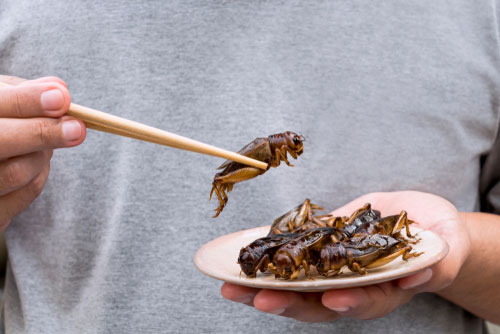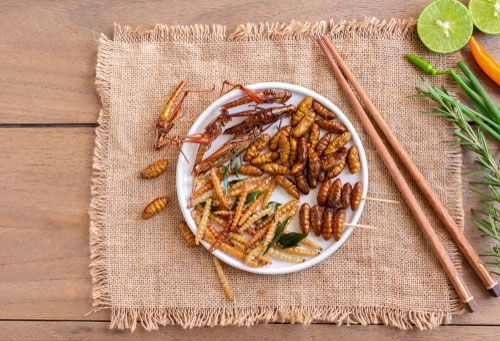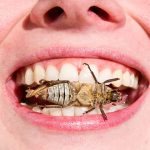There’s a big bug revolution around the corner. Why are insects reaching supermarket shelves, restaurant menus and ultimately, our plates? What are the benefits of eating bugs? Here’s some (weird and crunchy) food for thought.
Bugs Are Coming, And They Are Nutricionaly Nice
We have been here before. In the 14th century, people didn’t see coffee coming. As we entered this century, avocados still took their time before achieving today’s popularity – often misleading vegans unaware of their strong ecological impacts. Perhaps in 50 years, a cricket burger for lunch will be as common as a morning latte today.
The fact is: edible insects are slowly flying into the diet of Western people. We would (or maybe we still do) look at them as something disgusting, only to be eaten when facing real hunger situations. But according to a Barclay’s report, billion people in over 130 countries already regularly eat insects as a source of protein. And it’s not just protein, bugs are rich in amino acids, vitamins, and minerals too.
The UN expects the world population to grow and reach 9,7 billion people in 2050. And bugs are showing up as an interesting option (not a solution, because 1/3 of the world’s food going to waste is still a problem to be solved) not only to feed humans but other animals such as chickens, pigs or cows.
As The Bug Market Is Growing As It Gets More Regulated
Today, more explicit and clear regulations are being created on this matter by food and hygiene authorities. Like the recent one from the European Food Safety Authority what bugs themselves can be fed with, which insects can be sold and under which circumstances they need to be produced. As regulations like this one reduce uncertainty risks, it becomes an increasingly appealing market for entrepreneurs and investors to explore.
Research by Barclays suggests that the edible insect market is expected to exceed €7.1bn by 2030. According to TMR Research, this can be explained by the growing demands for protein-intensive products among middle-class customers and populational growth. But also because of people’s insecurities regarding food today, together with the positive consensus on the positive impacts of insect consumption. The Asia Pacific region is expected to be the dominant region in the market with significant contributions from China, India, Sri Lanka, Bangladesh, and Malaysia.
Barclay’s report brings to memory that today it is plant-based meat alternatives that are disrupting the food market when it comes to protein consumption. They are now entering the menus of vegetarian/vegan and fast-food restaurants and can be found in some supermarkets too. But will people in the west ever get convinced to eat insects (entomophagy)?
The West Eating Bugs – The Price Factor

It is known for years now that commodity and price are some of the main factors influencing consumer purchasing decisions. This is why when we think about the number of people willing to start eating bugs, we need to take price into consideration.
Apart from the cultural stigma, to which we will get just now, price is still one of the main reasons preventing insects from getting to the mainstream. According to Barclay’s report, prices are still high. For instance, an 18g bag of Jimini’s garlic and herb mealworms costs €6.90, while Bugfoundation’s insect burgers (2 units) cost €5.99 and 12g of crunchy roasted crickets cost £1.
On the other hand, the market is starting to show some positive responses too. The price of cricket power has been falling over the last years. While in Finland it came down from €100/kg in 2017 to €50/kg in 2019, in Thailand it costs now around c€20/kg compared to c€30/kg in 2017. But even with prices coming down, isn’t it too far weird for people to try it or if they do, to ask for a repetition?
The West Eating Bugs – The “Yuck” And Weird Factors
Kebabs, curries, sushi or ramen were once considered weird foods too. Perhaps the convenience of a restaurant around the corner doesn’t make us think straight ahead that these are foods come from specific locations. Perhaps we do remember it when we see waiters who look culturally very different and using specific customs.
As we’ve seen, the market is developing with the curious note that the Israeli entrepreneurial ecosystem seems to be one of the most active on the insects’ and food markets. As the market does grow, and the offer of bugs increases – either in their original shape or via flours or burgers – so do the number of restaurants offering these options. Some of the most known ones are The Black Ant in New York and the Grub Kitchen in the UK.
But as Barclays puts it, when it came to eating raw fish (aka sushi), it went mainstream as it was streamed down from top-end restaurants through to the supermarket shelves. Slowly, this move and the whole idea of eating insects will likely start becoming more normal. This will be boosted with the help of consumers looking for a more sustainable diet (usually less meat-intensive) without becoming vegan. But is eating insects really more sustainable?
Growing Insects Is More Sustainable Than Growing Meat

According to Clark, bioeconomy specialist at Zero Waste Scotland, insect farming is a very valuable, circular economy way to reduce food waste while producing more protein using fewer resources. This happens because bugs (such as the black soldier fly) can be fed as they consuming certain types of regulated food waste.
According to Clark, insect farms are relatively easy to set up using shipping containers. They are way more sustainable because they don’t use such extensive fields as traditional farming does, in so many cases to feed livestock. For instance, mealworm production requires 43 % of the amount of land used for milk and 10 % of the land required for beef production (Oonincx, 2012). This suggests that there’s no real competition for land and water when it comes to producing bugs on a large scale.
Considering the use of the same area for growing insects or farming chicken or cattle, bugs would deliver about 100 times more protein every year, the expert said and studies such as the one with field crickets in Thailand confirm. Cows are inefficient from a mechanical production point of view – considering all the inputs they get and the amount of meat their body creates. The IPIFF argues that while bugs can on average convert 2 kg of feed into 1 kilo of body mass, cows need 8 kg of feed to do the same thing. As they also emit fewer greenhouse gases than cattle or pigs, experts believe bugs are a good idea from an environmental point of view.
Wait And Watch Bugs Become The New Normal
This piece about insects and the big bug revolution that’s to come is still somewhat bold as this is still a niche market nowadays. However, by looking at Barclay’s forecasts, self-claimed to still be conservative, speaking of a specific food industry expected to worth up to US$8bn by 2030 (+24% CAGR) doesn’t seem more anticipative than that risky.
The World Economic Forum’s risk report claimed food crises to be one of the main and most impactful risks of this starting decade. And do is climate inaction, together with the need to cut down emissions by 3,5% starting this year. This means more sustainable food alternatives are very likely to continue to develop favorably – as has been the case with plant-based alternatives.
Sushi, ramen or avocados were weird at first but they are very “normal” today. And so are paleo and ketogenic diets or plant-based burgers. As entrepreneurs, investors, producers, and retailers understand this market opportunity; together with the possibility of also producing interesting by-products such as biodiesel or organic fertilizers; the big bug market doesn’t look like a hard moonshot. It looks like we’re almost landing. Ask the American cricket snack company Six Food or the Finnish Entis and they’ll probably tell you they are already there.
[Image credits to bug, crickets, and worm on Shutterstock]

